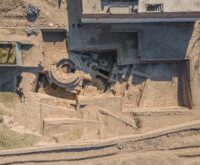 One the most ancient Buddhist temples in the world has been discovered in the ancient city of Barikot, in Pakistan’s Swat valley. It has been securely dated to the second half of the 2nd century B.C., but there’s evidence that it might date back further to the 3rd century B.C. when the area was part of the Maurya Empire.
One the most ancient Buddhist temples in the world has been discovered in the ancient city of Barikot, in Pakistan’s Swat valley. It has been securely dated to the second half of the 2nd century B.C., but there’s evidence that it might date back further to the 3rd century B.C. when the area was part of the Maurya Empire.
Barikot first appears in ancient sources as one of the cities besieged by Alexander the Great during his expedition to India in 327 B.C. It was an important city by then, an administrative center for all the agricultural products grown in the valley which has a unique microclimate that allows two rounds of crops to be sown and harvested in the same soil in the same year. Barikot grew wheat and rice and stored it. Alexander availed himself liberally of its granaries to supply his Indian campaign.
There is archaeological evidence that Barikot was settled continuously from around 1700 B.C. to the 16th century. In October 2021, archaeologists from the Italian Archaeological Mission excavated a site in the center of the ancient city that had been dug up by looters. They unearthed the remains of the walls of an ancient Buddhist temple that had been vandalized over the centuries.
The temple is over three meters tall and has a particular structure and shape. It is built on an apsidal podium on which stands a cylindrical structure that houses a small stupa. It is clearly an example of Buddhist architecture. On the sides of the front of the monument are a minor stupa, a cell, and the podium of a monumental pillar or column. The staircase leading to the cell has been reconstructed in three phases, the most recent dating back to the 2nd-3rd century AD, coeval with a series of vestibule rooms which used to lead to an entrance that opened onto a public courtyard overlooking an ancient road.
The oldest stairway of the monument bore in situ half of a step-riser with a dedicatory inscription inKharosthi, that can be dated to the 1st century AD on palaeographic grounds. The other half of the step-riser was found turned upside down, reused as a floor slab in the later phase of the monument. Moreover, archeologists found some coins in the inferior strata, along with many inscriptions written on ceramics in Kharosthi script. The monument was abandoned at the beginning of the 3rd century AD, when the lower city was destroyed by a devastating earthquake.
During the excavations, archaeologists discovered that the monument was built on the remains of an earlier structure flanked by a small, archaic stupa which precedes the Indo-Greek period, around 150 BC, during the reign of the Indo-Greek King Menander I or of one of his first successors. According to Indian Buddhist tradition, Menander I converted to Buddhism. Yet the site held even more surprises for the archaeologists — in December 2021, a few days before the end of the mission, they noticed that some parts of the Indo-Greek monument had been built on an even older structure whose strata included pottery materials and terracotta figurines which are likely to have been used in Barikot during the 4th and 3rd centuries BC.
More than 2000 objects have been documented and catalogued from the discovery, including pottery, coins, inscriptions, seals and jewelry. The dates will be confirmed by radiocarbon analysis of the semi-carbonate soil samples.